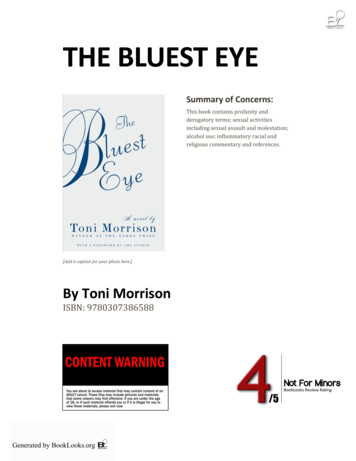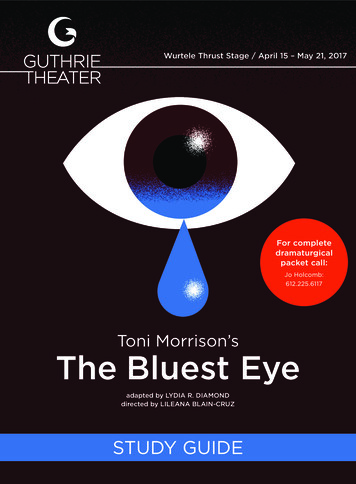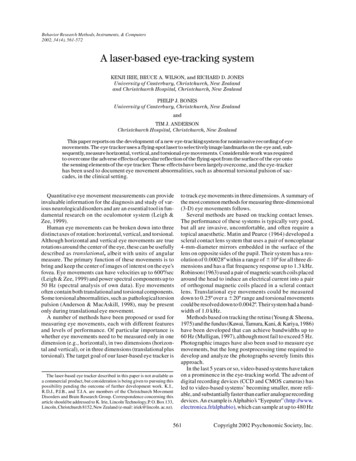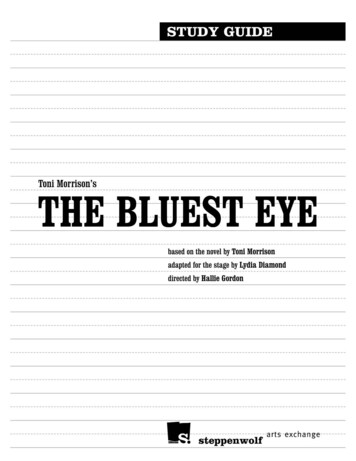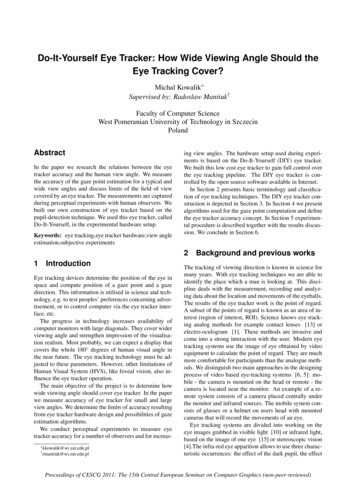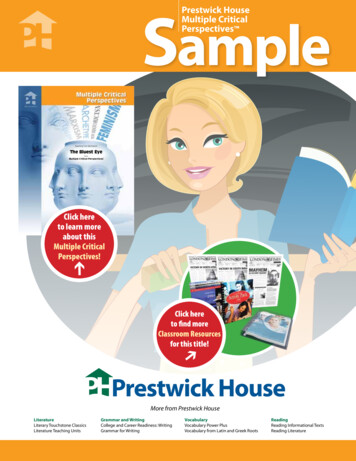
Transcription
SamplePrestwick HouseMultiple CriticalPerspectives Prestwick HouseTeaching Toni Morrison’sThe Bluest EyefromMultiple Critical Perspectives Click hereto learn moreabout thisMultiple CriticalPerspectives! Click hereto find moreClassroom Resourcesfor this title! Prestwick HouseMore from Prestwick HouseLiteratureLiterary Touchstone ClassicsLiterature Teaching UnitsGrammar and WritingCollege and Career Readiness: WritingGrammar for WritingVocabularyVocabulary Power PlusVocabulary from Latin and Greek RootsReadingReading Informational TextsReading Literature
Multiple CriticalPerspectivesTeaching Toni Morrison'sThe Bluest EyefromMultiple Critical Perspectives byRhonda Carwell
Multiple CriticalPerspectivesThe Bluest EyeGeneral Introduction to the WorkGenreThe Bluest Eye by Toni Morrison is a novel, in part a coming-of-age story and in part a modern tragedy.There are elements of both realism and postmodernism in the action, characterization, themes, andnarrative voices.6Pr e s t w i c kHo u s e,In c.
The Bluest EyeMultiple CriticalPerspectivesFeminist Theory Appliedto The Bluest EyeNotes on the Feminist TheoryFeminism is an evolving philosophy,and its application in literatureis a relatively new area of study. The basis of the movement, bothin literature and society, is that the Western world is fundamentallypatriarchal (i.e., created by men, ruled by men, viewed through the eyesof men, and judged by men).In the 1960s, the feminist movement began to form a newapproach to literary criticism. Of course, women had already been writingand publishing for centuries, but the 1960s saw the rise of a feministliterary theory. Until then, the works of female writers (or works aboutfemales) were examined by the same standards as those by male writers(and about men). Women were thought to be less intelligent than men,at least in part because they generally received less formal education,and many women accepted that judgment. It was not until the feministmovement was well under way that women began examining old texts,reevaluating the portrayal of women in literature, and writing new worksto fit the developing concept of the “modern woman.”The feminist approach is based on finding and exposing suggestionsof misogyny (negative attitudes toward women) in literature. Feministsare interested in exposing the undervaluing of women in literature thathas long been accepted as the norm by both men and women. Theyhave even dissected many words in Western languages that reflect apatriarchal worldview. Arguing that the past millennia in the Westhave been dominated by men—whether the politicians in power or thehistorians recording it all—feminist critics believe that Western literaturereflects a masculine bias, and, consequently, represents an inaccurate andpotentially harmful image of women. In order to repair this image andachieve balance, they insist that works by and about women be added tothe literary canon and read from a feminist perspective.Pr e s t w i c kHo u s e,In c.13
The Bluest EyeMultiple CriticalPerspectivesActivity OneUnderstanding the impact of gender on character development1. Copy and distribute the handout: The Bluest Eye: Feminist Activity One: Comparing Male andFemale Characters.2. As a class, briefly discuss whether Pauline is a sympathetic character. Have students provide andmake note of the source(s) of this sympathy or lack of it.3. Similarly, have the class briefly discuss whether Cholly is a sympathetic character and why (or why not).4.Divide the class into an even number of pairs or groups.5. Assign half of the groups (or allow them to choose) to examine Pauline while the other halfexamines Cholly.6. Have each group review the chapters that tell Pauline’s and Cholly’s stories and list pertinentfacts about the story and how it is told on the handout. As the examples indicate, students shoulduse the rectangles to state the facts and the ovals to discuss the significance of that fact to theirunderstanding of, and sympathy with, their character.7. Redistribute the groups so that each new group has at least one member who examined Paulineand at least one who examined Cholly.8. Have them share their findings with their new groups and have every student complete his or hergraphic.9.Reconvene the class and allow students to share their findings.10.As a class, discuss the following: What overall impression is made of Pauline as a woman and Cholly as a man? Are those imagespositive or negative? Why? Who is the stronger of the two characters? What could be the reason for this? Would it be seenin the same way within the society in which they live? In what ways are Pauline and Cholly shown to be dependent on each other? Is it a healthydependence? What differences can be seen in how each character is revealed to the reader? Whom does thereader come to “know” better? Why? What might this say about men and women in general?Pr e s t w i c kHo u s e,In c.17
The Bluest EyeMultiple CriticalPerspectivesFormalism Appliedto The Bluest EyeNotes on the Formalist ApproachThe formalist approach to literaturewas developed at thebeginning of the 20th century and remained popular until the1970s, when other literary theories began to gain popularity. Today,formalism is generally regarded as a rigid and inaccessible means ofreading literature, used in Ivy League classrooms and as the subjectof scorn in rebellious coming-of-age films. It is an approach that isconcerned primarily with form, as its name suggests, and thus placesthe greatest emphasis on how something is said, rather than what issaid. Formalists believe that a work is a separate entity—not at alldependent upon the author’s life or the culture in which the workis created. No paraphrase is used in a formalist examination, and noreader reaction is discussed.Originally, formalism was a new and unique idea. Theformalists were called “New Critics,” and their approach to literaturebecame the standard academic approach. Like classical artists such asda Vinci and Michaelangelo, the formalists concentrated more on theform of the art rather than the content. They studied the recurrences,the repetitions, the relationships, and the motifs in a work in orderto understand what the work was about. The formalists viewed thetiny details of a work as nothing more than parts of the whole. Inthe formalist approach, even a lack of form indicates something.Absurdity is in itself a form—one used to convey a specific meaning(even if the meaning is a lack of meaning).The formalists also looked at smaller parts of a work tounderstand the meaning. Details like diction, punctuation, andsyntax all give clues.Pr e s t w i c kHo u s e,In c.23
The Bluest EyeMultiple CriticalPerspectivesActivity OneExamining characters’ contributions to the novel1. Copy and distribute the handouts: The Bluest Eye: Formalist Approach Worksheet One: Everyoneis Important and The Bluest Eye: Formalism Activity One Character Map.2.As a whole class, make a list of the characters of The Bluest Eye.3. Categorize each character as major, secondary, or minor. Allow students to discuss the placementof each character. If there are disagreements over a certain character, allow students to place thatcharacter where they believe he or she belongs.4.Divide the class into an even number of pairs or small groups.5. Assign half the groups (or allow them to choose) to complete the Everyone is Important handout.Have the other half complete the character map.6.Redistribute the groups so that each new group has students who completed each of the handouts.7.Have students in their new groups share their responses.8. Reconvene the class and discuss the role, function, and importance of secondary and minorcharacters in the novel.Pr e s t w i c kHo u s e,In c.27
The Bluest EyeMultiple CriticalPerspectivesPsychoanalytic TheoryApplied to The Bluest EyeNotes on the Psychoanalytic ApproachThe term “psychological”(also “psychoanalytical” or “FreudianTheory”) seems to encompass two almost contradictory criticaltheories. The first focuses on the text itself, with no regard to outsideinfluences; the second focuses on the author of the text.According to the first view, reading and interpretation are limitedto the work itself. One will understand the work by examining conflicts, characters, dream sequences, and symbols. In this way, the psychoanalytic theory of literature is similar to the Formalist approach.One will further understand that a character’s outward behavior mightconflict with inner desires, or might reflect as-yet-undiscovered innerdesires.Main areas of study/points of criticism of the first view: There are strong Oedipal connotations in this theory: the son’sdesire for his mother, the father’s envy of the son and rivalryfor the mother’s attention, the daughter’s desire for her father,the mother’s envy of the daughter and rivalry for the father’sattention. Of course, these all operate on a subconscious levelto avoid breaking a serious social more. There is an emphasis on the meaning of dreams. This is because psychoanalytic theory asserts that it is in dreams that aperson’s subconscious desires are revealed. What a person cannot express or do because of social rules will be expressed andaccomplished in dreams, where there are no social rules. Mostof the time, people are not even aware what it is they secretlydesire until their subconscious goes unchecked in sleep.Pr e s t w i c kHo u s e,In c.43
The Bluest EyeMultiple CriticalPerspectivesActivity OneExamining the novel for evidence of the Id, Ego, and Superego1. As a class, review the information on the id, ego, and superego in the Notes on PsychoanalyticTheory. Discuss the main characteristics of each component.2. With the class, generate a list of characters from The Bluest Eye who have a direct impact on the maincharacters, Claudia, Frieda, and Pecola. Be certain the list includes: Pauline Breedlove Cholly Breedlove Claudia Frieda Junior Pecola Poland, China, and Miss Marie (divided or together) Soaphead Church Geraldine Maureen Mr. Henry3.Divide the class into three groups or a number of groups divisible by three.4.Assign each group, or allow each to choose, one of the three components of the personality.5. Have the groups then determine which characters in the list might, by their role in the story, relationship to the main characters, or by their actions, represent the group’s assigned component.6.Have the groups note evidence from the story to support their interpretation.7. Reconfigure the groups so that each new group has at least one representative of the id, ego, andsuperego. Have them share their findings and discuss any discrepancies, especially instances of assigning the same character to more than one component of the subconscious.NOTE: While the students discuss these discrepancies, as long as each cannot support the character’s assignment with an accurate understanding of Freud’s theory and of the text, students do not need to agree or cometo consensus.8.Reconvene the class and discuss the various characters’ roles.Pr e s t w i c kHo u s e,In c.47
The Bluest Eye Perspectives Activity One Examining characters' contributions to the novel 1. Copy and distribute the handouts: The Bluest Eye: Formalist Approach Worksheet One: Everyone is Important and The Bluest Eye: Formalism Activity One Character Map. 2. As a whole class, make a list of the characters of The Bluest Eye. 3.




